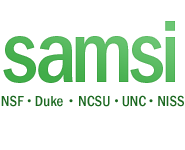2015-16: CCNS: Workshop on Optical Imaging Data Analysis: February 1-2, 2016
Workshop Information
This workshop was held at SAMSI in RTP. It was by invitation only.
Description:
Optical imaging is widely considered the most promising technology to achieve the aims of the BRAIN initiative. New indicators of neural activity are being developed every year, and imaging technology improves continually. These data will revolutionize neuroscience, just as microarrays revolutionized genomics, and should be similarly fruitful as a stimulus to innovation in statistics. Nevertheless there are almost no statisticians currently working with these data, both because these data are unfamiliar and are harder to access. This workshop would aim to introduce many statisticians to these data and present the major issues at present and expected in the near future.
The objectives are to introduce statisticians to the characteristics of optical technologies and to the kinds of statistical questions that are pressing now and may be appearing in the near future and to stimulate discussion about promising approaches to the largely unsolved statistical challenges of the new high-throughput optical data.
Directorate Liaison: Tom Witelski
Send questions to: [email protected]
Schedule
Monday, February 1, 2016
at SAMSI
| 9:00-9:15 a.m. | Opening Remarks: Mark Reimers, Michigan State University |
| 9:15-10:00 | KeyNote: Bruce McNaughton, University of California, Irvine Neuroscience Questions Opened up by Optical Imaging |
| 10:00-10:40 | Session 1: Optical Technologies and Experiments Yiyang Gong, Duke University |
| 10:40-11:00 | Break |
| 11:00-12:30 | Session 1: Optical Technologies and Experiments (continued) Matthew Valley, Allen Institute for Brain Science Strategies for Large-scale Calcium Imaging in the Mouse Brain Dieter Jaeger, Emory University |
| 12:30-1:30 | Lunch |
| 1:30-3:00 | Session2: Pre-processing Issues Part I: Calcium Imaging Eftychios Pnevmatikakis, Simons Foundation Brief Reports and Issues Michael Lavine, University of Massachusetts, Amherst Dynamic Linear Models for Neuronal Optical Images Traces from Calcium-sensitive Dyes Valentina Staneva, University of Washington Can We Extract Neuropil Signal Automatically? Pengcheng Zhou, Carnegie Mellon University Discussion of Outstanding Issues |
| 3:00-3:20 | Break |
| 3:20-5:00 | Session 2: Pre-processing Issues (continued) Part II: Voltage Imaging Alexandre Reynaud, McGill University Linear Model Decomposition for Voltage-sensitive Dye Imaging Signals: application on awake monkey Brief Reports and Issues: Ming Yan, Michigan State University Mark Reimers, Michigan State University |
| 5:00-5:30 | Working Groups |
| 5:30-7:00 | Reception (2nd Fl Commons) and Software Tutorials (Room 150) |
Tuesday, February 2, 2016
at SAMSI
| 9:00-10:15 a.m. | Session 3: Handling Big Data Jason Wittenbach, HHMI Janelia Farm Challenges and Opportunities in Scalable Analysis of Neural Imaging Data Brief Reports and Issues: Ming Yan, Michigan State University |
| 10:15-10:45 | Break |
| 10:45-12:15 | Session 4: Network and Connectivity Analysis Yu Hu, Harvard University Brief Reports and Issues: Yuying Xie, Michigan State University Mark Reimers, Michigan State University |
| 12:15-1:15 | Lunch |
| 1:15-2:45 | Session 5: Dimension Reduction and State-Space Dynamics Brief Reports and Issues: Kathleen Champion, University of Washington Determining the Dimensionality of Brain-wide Activity from Calcium Imaging Data Mark Reimers, Michigan State University Casey Diekman, New Jersey Institute of Technology Grace Hong, Michigan State University |
| 2:45-3:00 | Break |
| 3:00 | Wrap-up Discussion Note: Most sessions will begin with a 35-min talk with 10 min questions by a leading speaker, and continue with several 5-10 min brief reports, and selected discussion questions. |
